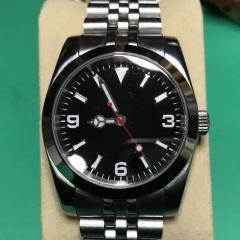Making Springs—Click, Lever, etc.
-
Recently Browsing
- No registered users viewing this page.
-
Topics
-
Posts
-
By Neverenoughwatches · Posted
Its good to understand how and why demagnetisers work. These two pieces of text explain in basic terms how ferrous metal is affected by magnetism and why they can retain some of those properties. The cheap demagnetiser is actually a magnetiser,but is used in a way that can remove the weak magnetic properties that a steel has gained through magnetic field exposure. -
Yeah, agree on the rotation thing - I'll use this as my work beater, and rotate between the others outside of that I think. The 'problem' is with these that in many cases the parts are worth more separately than in a bad example: assume the bezel, dial and movement the same seller is getting rid of came from the same watch... If he sells them all he'll get a similar price to a really good condition example. There's a good side to that though - it means you can often find the odd bit you need. And I paid less for this case and crystal assembly than I did for a crystal and dial holding ring I bought for another project, so there's still value to be had occasionally.
-
By LittleWatchShop · Posted
Cheap ginger counters will tell you if you have radium, but don't waste your money and don't worry about it. -
Nice rescue. I like when a few with heavy patina are worn in rotation with nicer watches of a collection. Frankens, too so long as they aren’t passed off as something else. My experience with these Seikos is they tended to disintegrate on their own so finding correct parts to put an original together is near impossible…
-
Some answers from my view screwdrivers - if the bodies are ok for you maybe only look at changing the blades if possible, probably 100 and 140 first. loupes - 3-3.5 is what is normally recommended for disassembly and assembly, 10x for inspection digital microscope - not great for working on movements as there is no depth perception, great for inspection and taking photos to post here 😀 automatic oilers - a bite marmite/vegemite at times, various opinions, some swear by them, some use them only for certain jewel settings others don’t care for them at all. They are not at all necessary, the usual alix etc. ones are fine and you don’t need to spend a fortune. They are very subjective though, you may end up making your own from a needle and peg wood because you like it just so. can’t help with the Geiger counter, I’m one of the ones who don’t get freaked out about it. There is a legitimate concern, however as long as your not licking the dials/hands, or snorting the degraded old powder you are likely to be absolutely fine. Tom
-



.thumb.jpg.19a9c4ff164d78d516aa9f05a063752b.jpg)






Recommended Posts